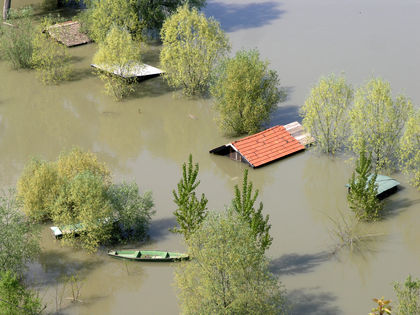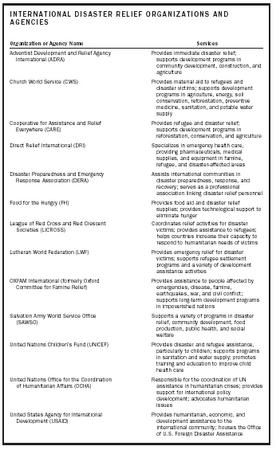Disaster Relief Organizations

Natural disasters, as well as some human-caused disasters, lead to human suffering and create needs that the victims cannot alleviate without assistance. Examples of disasters include hurricanes, tornadoes, floods, earthquakes, drought, blizzards, famine , war, fire, volcanic eruption, a building collapse, or a transportation wreck. When any such disaster strikes, a variety of international organizations offer relief to the affected country. Each organization has different objectives, expertise, and resources to offer, and several hundred may become involved in a single major disaster. International disaster relief on such a large scale must be properly coordinated to avoid further chaos and confusion both during and after the disaster.
Assessment
In the event of a disaster, the government of the affected country must conduct a needs assessment to determine what emergency supplies and personnel are required. These needs should be communicated to those relief organizations that will potentially provide assistance. The process of requesting and receiving supplies is lengthy and includes many events that could delay the arrival of assistance. Requests for assistance must first be reviewed and approved by relief organizations, and then supplies and personnel must be collected and transported to the disaster site. Effective management of relief assistance depends on anticipating and identifying problems, and on delivering specific supplies and personnel at the times and places they are needed.
Health Risks
Disasters often pose significant health threats. One of the most serious concerns after a disaster, especially a natural disaster, is sanitation. Disruptions in water supplies and sewage systems can pose serious health risks to victims because they decrease the amount and quality of available drinking water and create difficulties in waste disposal. Drinking water can be contaminated by breaks in sewage lines or the presence of animal cadavers in water sources. These factors can facilitate the spread of disease after a disaster. Providing potable drinking water to victims and adopting alternative methods of sanitation must be a priority after a disaster.
Food shortages are often an immediate health consequence of disasters. Existing food stocks may be destroyed or disruptions to distribution systems may prevent the delivery of food. In these situations, food relief programs should include the following elements: (1) assessment of food supplies available after the disaster, (2) determination of the nutritional needs of victims, (3) calculation of daily food needs, and (4) surveillance of victims' nutritional
![A woman gets her monthly distribution of food at a disaster-relief center in Baghdad. Following the 2003 war in Iraq, hundreds of relief agencies provided support to affected citizens. [Photograph by Caroline Penn. Corbis. Reproduced by permission.]](../images/nwaz_01_img0078.jpg)
After a disaster, victims must be protected from hazardous climatic conditions, such as severe temperatures or precipitation. People should be kept dry, reasonably well clothed, and able to access emergency shelter.
Disasters can also cause disruptions to the health care infrastructure. Hospitals and health centers may suffer structural damage, or health personnel may be among the casualties, limiting the ability to provide health services to disaster victims. Emergency Health Kits that contain essential medical supplies and drugs are often provided to victims as part of the immediate response to disasters. Developed through the collaboration of various relief organizations, these kits are designed to meet the primary health care needs of people without access to medical facilities. Each kit covers the needs of about 10,000 persons for three months, at a cost of about fifty cents per person. The twelve essential drugs in the basic kit include anti-inflammatories, an antacid, a disinfectant, oral dehydration salts, an antimalarial, a basic antibiotic (effective against the most common bacteria ), and an ointment for eye infections. These medicines can treat the most common illnesses of disaster victims, such as anemia , pain, diarrhea, fever, respiratory tract infections, eye and ear infections, measles, and skin conditions. The basic kit also includes simple medical supplies such as cotton, soap, bandages, thermometers, some medical instruments, health cards and record books, and items to help create a clean water supply.
Risk of Disease
Natural disasters do not usually result in infectious disease outbreaks. However, certain circumstances can increase the chance for disease transmission. Immediately after a disaster, most increases in disease incidence are caused

| Organization or Agency Name | Services |
| Adventist Development and Relief Agency International (ADRA) | Provides immediate disaster relief; supports development programs in community development, construction, and agriculture |
| Church World Service (CWS) | Provides material aid to refugees and disaster victims; supports development programs in agriculture, energy, soil conservation, reforestation, preventive medicine, sanitation, and potable water supply |
| Cooperative for Assistance and Relief Everywhere (CARE) | Provides refugee and disaster relief; supports development programs in reforestation, conservation, and agriculture |
| Direct Relief International (DRI) | Specializes in emergency health care, providing pharmaceuticals, medical supplies, and equipment in famine, refugee, and disaster-affected areas |
| Disaster Preparedness and Emergency Response Association (DERA) | Assists international communities in disaster preparedness, response, and recovery; serves as a professional association linking disaster relief personnel |
| Food for the Hungry (FH) | Provides food aid and disaster relief supplies; provides technological support to eliminate hunger |
| League of Red Cross and Red Crescent Societies (LICROSS) | Coordinates relief activities for disaster victims; provides assistance to refugees; helps countries increase their capacity to respond to humanitarian needs of victims |
| Lutheran World Federation (LWF) | Provides emergency relief for disaster victims; supports refugee settlement programs and a variety of development assistance activities |
| OXFAM International (formerly Oxford Committee for Famine Relief) | Provides assistance to people affected by emergencies, disease, famine, earthquakes, war, and civil conflict; supports long-term development programs in impoverished nations |
| Salvation Army World Service Office (SAWSO) | Supports a variety of programs in disaster relief, community development, food production, public health, and social welfare |
| United Nations Children's Fund (UNICEF) | Provides disaster and refugee assistance, particularly to children; supports programs in sanitation and water supply; promotes training and education to improve child health care |
| United Nations Office for the Coordination of Humanitarian Affairs (OCHA) | Responsible for the coordination of UN assistance in humanitarian crises; provides support for international policy development; advocates humanitarian issues |
| United States Agency for International Development (USAID) | Provides humanitarian, economic, and development assistance to the international community; houses the Office of U.S. Foreign Disaster Assistance |
by fecal contamination of water and food supplies. This contamination usually results in intestinal disease. Outbreaks of communicable diseases are directly associated with population density and displacement. If disaster victims live in overcrowded conditions or are forced to leave their homes, the risk of a disease outbreak increases. An increased demand on water and food supplies, elevated risk of contamination, and disruption of sanitation services all contribute to the risk of a disease outbreak.
In the longer term after a disaster, the risk for vector-borne diseases increases. Vector-borne diseases are spread to humans by insects and other arthropods, such as ticks or mosquitoes. Vector-borne diseases are of particular concern following heavy rains and floods. Insecticides may be washed away from buildings and the number of mosquito breeding sites may increase. In addition, wild or domestic animals that have been displaced can introduce infection to humans.
International disaster relief organizations play an important role in the response to disasters. They provide valuable supplies and personnel to victims and help to minimize the social, economic, and health consequences of a disaster. Health concerns, such as potential disease outbreak, malnutrition, and poor sanitation, should be addressed immediately after a disaster to avoid serious health consequences. International relief organizations help victims fulfill unmet needs and play a vital role in effective disaster management.
SEE ALSO Emergency Nutrition Network ; Famine .
Karen Bryla
Bibliography
Gorman, R. F. (1994). Historical Dictionary of Refugee and Disaster Relief Organizations . Metuchen, NJ: Scarecrow Press.
Internet Resources
Pan American Health Organization. "Natural Disasters: Protecting the Public's Health." Available from <http://www.paho.org>
Grantmakers Without Borders. "International Emergency Relief Links." Available from <http://www.internationaldonors.org>
Disaster Center. "Disaster Relief Agencies." Available from <http://www.disastercenter.com/agency.htm>
Pan American Health Organization. "Disasters and Humanitarian Assistance." Available from <http://www.paho.org/disasters>
UNICEF. "Emergency Health Kits." Available from <http://www.supply.unicef.dk/emergencies/healthkit.htm>

also i think that your info is great.
and thank you.